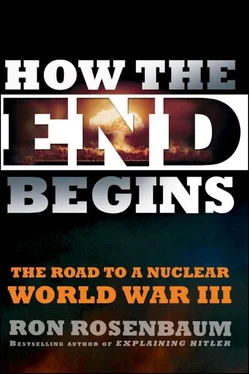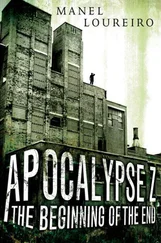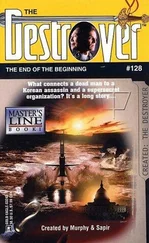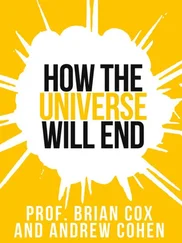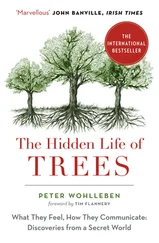They were a good-natured bunch, kind of like nerdy frat boys, the missileers, in their dark blue jumpsuits and shiny military-style ascots, but I still felt ill at ease asking them an uncomfortable question: What’s the point of carrying out the threat of retaliation, and committing genocide once the threat of deterrence has failed?
“One thing you have to assume,” a lanky missileer answered, “is that when I get an authenticated launch order I have to figure my wife and kids would be dead already up above. The base is ground zero. Why shouldn’t I launch? The only thing I’d have to look forward to if I ever got up to the surface would be romping around with huge mutant bunny rabbits.”
We all laughed. I’m not sure how funny it is in retrospect. It was a metaphor, it was black humor, he didn’t believe mutation occurred overnight. But it captured the absurdity of the horror they had learned somehow to be stoic about. My family is dead, there’s going to be nothing for me up there, so why not slaughter tens of millions of families on the other side of the world for no useful purpose?
Every time I thought back to the mutant bunny rabbits I wondered whether I should have felt more censorious about him taking it so lightly, but I think now it was his way of dealing with—insulating himself from—what lay beneath. The bunny rabbits were a distraction from the dead family, his dead children. He did not say it with even a hint of vengeful rage at the murder of his family “up above.” It came with the territory. It just didn’t seem real. And if it didn’t seem real to the man who would launch the missiles then, how real does it feel now?
I nervously persisted with questions of the missile crewmen: “Okay, if you assume that when you get the launch order everyone on our side has been devastated by a Soviet first strike, is there any purpose served by destroying what’s left of humanity by retaliating purely for revenge?”
One of the crewmen took what seemed like a more serious approach than the mutant bunny rabbit.
“What it all comes down to,” he said, “is the Judo-Christian ethic.”
“You mean Judeo-Christian?” one of the other missile crewmen said.
To this day I’m not sure if “Judo-Christian” was a malapropism, a kind of martial arts interpretation of the scriptures, or an equally deliberate send-up of them. But he stuck to “Judo,” perhaps conflating the martial art with the “eye-for-an eye” revenge dictum in the Old Testament.
“Right, like I said,” he continued, “the Judo-Christian ethic teaches that you never strike first, but if someone hits you, you can strike back.”
Looking back on it, “Judo-Christian” had a touch of the humor in Terry Southern’s dialogue for Sterling Hayden’s Colonel Jack D. Ripper to it.
I skipped over the Judo/Judeo matter and raised the question of Christianity, which, at least in the eye of those such as Hamlet, frowns upon revenge (as does Judaism with “vengeance is mine, sayeth the Lord” as the final word on the subject).
What about then President Jimmy Carter, I asked the crewmen, a self-professed born-again Christian, certainly well aware of the Bible’s instructions to “turn the other cheek” and “love thy enemy” despite having served on a nuclear submarine. He was president at the time. I asked the crewmen to imagine they were Carter and “for some reason the Soviets are tempted to strike or preempt our strike. You see those missiles coming in on the radar screen and know mass murder is about to happen to your people and there’s nothing you can do to stop it. Is there any point in committing another act of mass murder in return? You might succeed in exacting revenge, but you might not even succeed in killing those responsible for the attack while meanwhile you murdered tens of millions who had nothing to do with it.”
Looking back on it I was implicitly accusing these crewmen of willing complicity in potential mass murder.
The response that ended the discussion was this: “You think he should surrender?” one of the crewmen asked me.
“I don’t know,” I said, taken aback by the abruptness of his question. That would be surrender, wouldn’t it, however ethically, morally, and theologically correct?
Surrender. In 1958 Congress had actually passed a resolution forbidding the use of any defense appropriations to think tanks for the study of “surrender.” [105]It was a silly resolution prompted by the discovery that a RAND Corporation analyst had done a paper on “strategic surrender,” a comparative historical examination of how nations that surrendered in war had nonetheless found ways to maximize their position. [106]It argued, among other things, that the French in 1940, for instance, had done better than expected in their surrender negotiations while the Germans at Versailles turned a truce into a humiliating surrender, even though their military situation was far stronger than France’s a generation later. The main result of the congressional move was the development of a euphemism for surrender in the nuclear strategy community: “war termination.” It continued to be studied and generated a black-humored joke by Henry Kissinger in his 1960 book On Nuclear War where, in the index under “Surrender,” the reader finds “See victory, Total.”
But for another crewman in the group, twisting the keys was not a matter of genocide or surrender, but part of a routine in a day’s work. “That’s the thing you know,” this other crewman said, “Once you start thinking about all that your head starts going in circles. You got to change the subject. There’s a point where you gotta stop asking questions and go to work. You’ve got to have faith that you’re doing the right thing. It all comes down to professionalism. We know our presence here helps deter war and…” [107]
My source on Cold War nuclear submarine culture, Mel Halbach, who is making a documentary based on interviews with his fellow crewmen, says that they never stopped talking about the question of their inevitably genocidal retaliatory mission, and that the Navy never stopped worrying about whether they would actually follow a launch order because, he says, so many peaceniks joined the Navy to escape the draft. He recalls that every serious launch-related drill was executed with officers wearing guns and that a tommy gun was always present at the entrance to the engine room, for fear that crew would refuse to launch. [108]
In that bunker on that day, the missile men disclosed to me something I thought at the time was subversive: it turns out, they said, that it is possible to get around the fail-safe system that requires two men at some distance from each other to turn two keys simultaneously in order to launch a nuclear attack. For years I misinterpreted their revelation of the workaround as an act of rebellion. But they saw it as an instance of professionalism of the highest order.
The way the system worked at the time of my visit was that down in each of the underground launch control centers was a crew of two men who mainly sat at consoles awaiting the possibility of an alert or a launch order. They spent days going through endless drills in which they had to perform every item in a checklist of readiness, up to twisting their keys in the launch slots. [109]
Each of the two-man crew in the launch control capsule underground was assigned a key. Once they got the launch order they would feed the targeting codes into the missiles under their control, and then, when they’d been given the final go-ahead and made the final confirmation of the authenticity of the launch order, each of them would twist his key.
There was one condition. They had to twist them virtually simultaneously. And the two launch consoles with the key slots were built a distance apart, which kept one crewman from, say, twisting his own key with his left hand and reaching over to twist the other key with his right hand. In other words, he could not accomplish a launch alone.
Читать дальше
